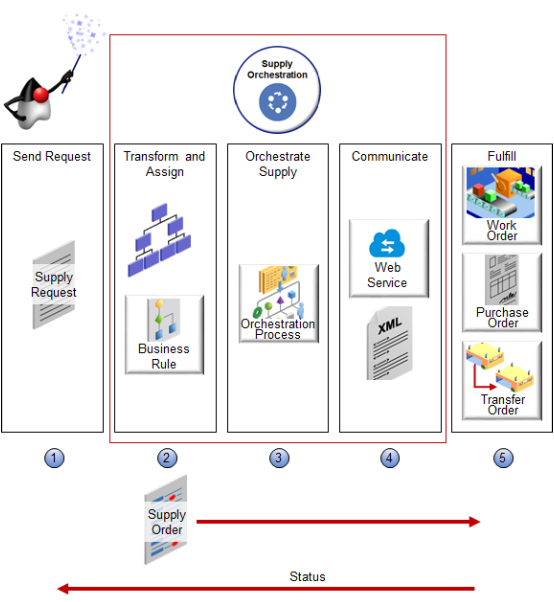How Supply Chain Orchestration Works
Supply Chain Orchestration uses orchestration processes and web services to create and manage supply.

-
Send request. An application sends a request to Supply Chain Orchestration to create supply.
Application
What the Application Does
Planning Central
Sends a request for a planned sales order to Supply Orchestration in a back-to-back flow, such as make, buy, or transfer. It might also include a make order for an inventory organization that you set up as contract manufacturer.
Order Promising
Order Management
-
Order Promising confirms the sales order, then sends supply data to Supply Chain Orchestration.
-
Order Management schedules the sales order, then sends demand data to Supply Chain Orchestration.
-
Supply Chain Orchestration combines the data it receives from Order Promising and Order Management into a single set of data, then starts a back-to-back flow.
Inventory
Min-Max Planning sends a make, buy, or transfer request to Supply Chain Orchestration.
File-Based Data Import
You use an Excel spreadsheet in the File-Based Data Import application to manually import request data into Supply Chain Orchestration.
-
-
Transform and assign request. Transform the supply request to a supply order. Run predefined rules or rules that you create.
Type of Rule
Description
Supply Order Defaulting and Enrichment Rule
Here's what you can do.
-
Map attribute values you receive in the supply request to values that your fulfillment system can use. If necessary, transform values to optimize fulfillment.
-
Modify an attribute on a purchase order, work order, or transfer order.
Here are some examples.
-
Set shipment priority.
-
Select your preferred supplier.
-
Set the currency so it matches the currency your customer uses.
-
Determine whether to use a transfer order or purchase order to process the transfer request. Determine whether to route the transfer through Order Management.
Execution Document Creation Rule
Specify the type of supply to transfer between inventory organizations, including the business process and document type to use between organizations.
Assignment Rule
Assign a predefined orchestration process to the supply order. Supply Chain Orchestration uses different orchestration processes to manage supply. Each process optimizes processing according to the type of flow, such as a make flow.
Use a scheduled process to periodically run each orchestration process. For details, see Use Composites to Plan Supply.
-
-
Orchestrate supply order. The orchestration process contains steps that create supply and do fulfillment tasks. For example, the process might call a manufacturing system to create or modify a manufacturing work order, or a purchasing system to create or change the quantity on a purchase order.
Here's how the orchestration process manages tasks.
-
Process planning. Determine the start and end date for each process step. Use the duration of each task to schedule the overall process.
-
Change management. Identify and respond to changes that happen in supply or demand during processing. Make adjustments to keep supply and demand in balance.
-
Tracking. Track progress of each step, track the status and state of execution documents, and the overall process.
For example, the back-to-back process includes steps. Each step does a task.
-
Call the procurement system to create a purchase order.
-
Call the inventory system to reserve a purchase order for the demand.
-
Receive supply in the warehouse.
-
-
Communicate. The flow calls a web service and uses it to send and receive messages to and from each fulfillment system.
-
Create an XML payload that's specific to each fulfillment system, then send it to the fulfillment system.
-
Receive updates from the fulfillment system and send them to the orchestration process for change management. For example, receive and send a status change or quantity decrease on a purchase order.
-
-
Fulfill. The fulfillment system uses supply to create and fulfill the item. For example:
-
A manufacturing plant uses supply in a work order in a make flow to build the item.
-
A purchasing organization uses a purchase order to purchase the item from a supplier in buy flow.
-
A warehouse uses supply in a transfer order in a transfer flow to transfer inventory from one warehouse to another warehouse.
-
Supply Chain Orchestration communicates status to the application that requests supply during fulfillment.